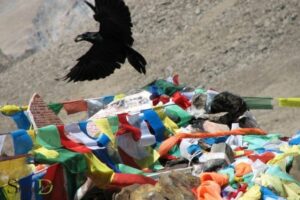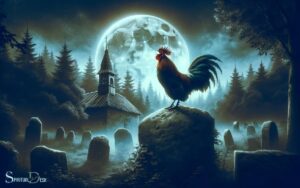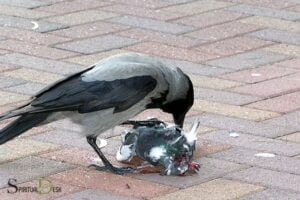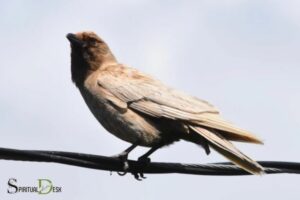Crow Indian Spiritual Beliefs: A Connection to The Land!
Crow Indian spiritual beliefs center around a connection to the land, animals, and the Great Spirit.
They involve a reverence for the land, rituals for spiritual guidance, and the presence of water, air, and fire.
The Crow Indians believe in a powerful creator, known as “First Maker” or “Big Man.” They also hold a strong belief in supernatural entities, including both benevolent and malevolent spirits.
The spiritual life of the Crow Indians is filled with various rituals and ceremonies, which are seen as a way to maintain balance and harmony with the natural world.
It plays an integral role in their community, influencing their social structure, ethical conduct, and cultural practices.
Four main aspects of Crow Indian spiritual beliefs:
Crow Indian spiritual beliefs are deeply rooted in their reverence for the natural world and the interconnectedness of all beings.
This philosophy forms the basis of their rituals, ethics, and social conduct, underscoring the essential role spirituality plays in their community.
Their unique spiritual system provides a rich cultural identity that continues to shape their way of life in contemporary times.
7 Spiritual Beliefs of Crow Indian
| Belief | Description |
| Great Spirit | Crow Indians believed in a supreme, all-powerful entity known as the Great Spirit, who had control over human destiny. |
| Animal Spirits | They believed that animals had spirits and that some of these spirits could help or harm humans. |
| Afterlife | They believed in an afterlife, a place where humans went after they died. |
| Spiritual Guides | The Crow often sought guidance from spiritual beings through vision quests and dreams. |
| Medicine Bundles | These were sacred objects used in ceremonies and prayers, believed to have spiritual powers. |
| Sacred Circle | The concept of the circle was sacred and important, representing the continuity and completeness of life. |
| Sun Dance | This was an important religious ceremony of prayer, sacrifice, and renewal. |
Key Takeaway
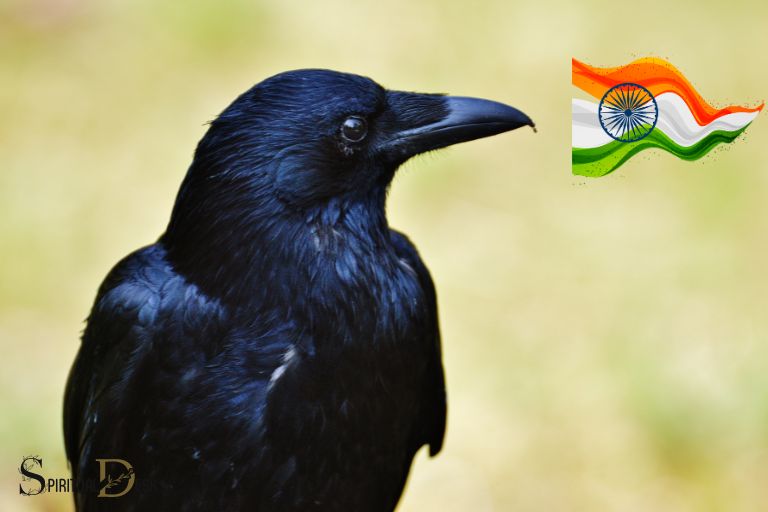
Five Facts About: Spiritual Beliefs of Crow Indian
Key Features Of Crow Indian Spiritual Beliefs
The crow indian tribe, also known as the aps�alooke, have a rich spiritual belief system deeply intertwined with their cultural heritage.
These beliefs are based on a profound respect for the land and nature, the role of spirits and ancestors, and a strong connection to the animal world.
Sacredness Of Land And Nature
- The crow indians view the land and nature as sacred and deeply interconnected with their spirituality.
- They believe that all natural elements, such as mountains, rivers, and animals, possess a spirit that should be respected and honored.
- The land is considered a living being, providing sustenance and spiritual guidance to the tribe.
- Environmental harmony and preservation are essential for maintaining a balanced relationship with nature.
Role Of Spirits And Ancestors
- Spirits and ancestors hold a significant place within crow indian spiritual beliefs. They are seen as powerful beings who can influence and guide the living.
- The spirits of deceased ancestors are believed to continue their journey in the spirit world and can be called upon for guidance and protection.
- Rituals, such as sweat lodges and vision quests, are conducted to establish a connection with the spirit world and seek spiritual enlightenment.
- The crow indians believe that spirits can offer wisdom, healing, and intervention in their daily lives.
Connection To The Animal World
- The crow indians have a deep connection to the animal world, considering animals as spiritual guides and teachers.
- Each animal is believed to possess unique qualities and characteristics that can offer guidance and lessons for human life.
- Animals often appear in visions, dreams, and ceremonies, carrying messages from the spiritual realm.
- Animal symbolism is an integral part of crow indian spirituality, with individuals having animal spirits or totems associated with them.
Overall, the crow indian spiritual beliefs are rooted in a profound respect for the land and nature, a strong connection to spirits and ancestors, and a deep understanding of the animal world as a source of wisdom and guidance.
This spiritual framework shapes their daily lives, ceremonies, and relationships with the natural world around them.
Sacred Rituals And Ceremonies
Throughout history, the crow indians have held a deep spiritual connection to the natural world and the unseen forces that govern it.
These beliefs are brought to life through a variety of sacred rituals and ceremonies that play a central role in the crow spiritual practices.
Let’s take a closer look at three of the most significant ceremonies: the sun dance, vision quest, and sweat lodge.
Sun Dance: A Central Spiritual Event
The sun dance is one of the most important and widely recognized ceremonies in crow culture. Taking place during the summer months, this sacred ritual is a time of prayer, fasting, and sacrifice.
Here are some key aspects of the sun dance:
- Tribal gathering: The sun dance brings the crow community together, fostering unity and spiritual connection among the participants.
- Dance circle: Central to the ceremony is the dance circle, where participants engage in rhythmic dancing to honor the sun and seek blessings from the spirits.
- Sacred tree: A tall cottonwood tree is erected in the center of the dance circle, symbolizing the connection between the heavens and earth.
- Piercing ritual: Some participants choose to undergo the piercing ritual, where small wooden skewers are inserted into the flesh, symbolizing sacrifice and endurance.
- Prayer and fasting: Participants fast for several days leading up to the sun dance, abstaining from food and water to purify the body and strengthen spiritual connection.
- Renewal and healing: The sun dance is believed to bring renewal and healing to the community, fostering spiritual growth and harmony within the tribe.
Vision Quest: Seeking Guidance From The Spirits
The vision quest is a deeply personal and transformative experience for individuals seeking spiritual guidance and revelation.
Here are the key aspects of the vision quest:
- Solitary retreat: Participants embark on a solitary retreat into the wilderness, seeking solitude and communion with nature.
- Sacred objects: Individuals bring sacred objects such as prayer bundles, tobacco, and feathers to connect with the spirits and seek guidance.
- Fasting and purification: During the vision quest, participants fast and cleanse their bodies through purification rituals such as sweat lodges.
- Communion with spirits: Through prayer, meditation, and connection with the natural world, participants seek visions and spiritual guidance from the spirits.
- Revelation and self-discovery: The vision quest is a transformative journey that often leads to profound insights, self-discovery, and direction in life.
Sweat Lodge: Purification And Spiritual Renewal
The sweat lodge ceremony is a powerful and sacred ritual that allows participants to cleanse their bodies, minds, and spirits.
Here are the key aspects of the sweat lodge ceremony:
- Structure and symbolism: The sweat lodge is a dome-shaped structure made of natural materials, symbolizing the womb of mother earth.
- Heat and purification: Stones are heated and placed in the center of the lodge, releasing steam as water is poured onto them. The intense heat promotes sweating and purification.
- Prayer and introspection: Participants engage in prayer and reflection, seeking spiritual connection, clarity, and guidance.
- Rebirth and renewal: The sweat lodge is seen as a place of rebirth, where individuals shed their old selves and emerge spiritually renewed.
- Healing and reconciliation: The ceremony provides a space for healing, reconciliation, and restoring balance in the lives of participants.
These sacred rituals and ceremonies are integral to the spiritual beliefs and practices of the crow indians.
Through the sun dance, vision quest, and sweat lodge, individuals and the community as a whole connect with the divine, seeking guidance, renewal, and spiritual growth.
Beliefs About Death And The Afterlife
In crow indian spiritual beliefs, death holds a significant place and is viewed as a transition rather than an end.
The afterlife is believed to be interconnected with the physical world, and various customs and rituals are practiced to honor the deceased.
Let’s delve deeper and explore the fascinating aspects related to funeral customs and rituals, the legacy of ancestors, and the perspectives on the afterlife within crow indian culture.
Funeral Customs And Rituals:
- Funeral practices among the crow indians are deeply rooted in their spiritual beliefs and cultural traditions. These customs aim to guide the soul of the departed and offer comfort to the living.
- The body of the deceased is traditionally dressed in their finest clothes, adorned with meaningful objects, and laid to rest on a raised scaffold so that the spirit can easily embark on its journey to the afterlife.
- During the funeral ceremony, mourners gather to pay their respects and offer support to the bereaved family. Prayers, songs, and recounting of the deceased’s accomplishments are part of the ritual, ensuring a dignified departure.
Legacy Of Ancestors In Crow Indian Culture:
- Ancestor reverence and the belief in the interconnectedness of past, present, and future generations are core tenets of crow indian culture.
- Ancestors are respected and seen as guardians and guides in the spiritual realm. Their wisdom, experiences, and accomplishments are valued and celebrated, contributing to the understanding of individual and collective identity.
- The legacies of ancestors are passed down through oral traditions, storytelling, ceremonies, and symbols, fostering a strong sense of cultural pride and heritage within the crow community.
Perspectives On The Afterlife:
- According to crow spiritual beliefs, the afterlife is not an entirely separate realm but rather intertwined with the physical world. It is a continuation of the spiritual journey, where spirits can interact with the living and influence their lives.
- The afterlife is perceived as a place of peace and tranquility, where individuals can reunite with their loved ones and ancestors. It is believed that the spirits of the deceased continue to offer guidance and protection to their living descendants.
- Crow indian spiritual practices often involve communication with the spirits of the departed through ceremonies, visions, dreams, and other forms of divine connection. These interactions provide comfort and assurance about the continuity of life beyond death.
Crow indian spiritual beliefs regarding death and the afterlife embrace a holistic and interconnected worldview. Funeral customs and rituals honor the departed, while the legacy of ancestors permeates the cultural fabric.
Perspectives on the afterlife emphasize continuity, the presence of spirits, and the significance of maintaining a strong bond between the living and the deceased.
This rich spiritual tapestry demonstrates the deep-rooted beliefs and values of the crow people, showcasing the enduring power of their spiritual traditions.
Contemporary Influence And Preservation
The spiritual beliefs of the crow indian tribe have a rich and profound history that continues to shape their lives today. In this section, we will explore the contemporary influence and preservation of crow indian spiritual beliefs.
From the impact of colonization to efforts in preserving traditions and modern adaptations of spiritual beliefs, the crow tribe has navigated a complex path to maintain their cultural heritage.
Impact Of Colonization On Crow Indian Spiritual Beliefs:
- European colonization had a significant impact on crow indian spiritual beliefs, as the introduction of christianity and the suppression of indigenous religions caused a shift in beliefs and practices.
- Missionaries played a key role in introducing christianity, which led to the erosion of traditional spiritual practices and the assimilation of crow indians into the dominant culture.
- The loss of land, forced relocation, and cultural assimilation further marginalized the influence and practice of crow indian spiritual beliefs.
Efforts To Preserve And Revitalize Traditions:
- Despite the challenges faced by colonization, the crow tribe has made concerted efforts to preserve and revitalize their traditional spiritual beliefs.
- Tribal elders and cultural leaders have played a vital role in passing down knowledge and teachings to younger generations, ensuring the continuity of spiritual traditions.
- The establishment of cultural centers and educational programs has provided a platform for the preservation and promotion of crow indian spiritual beliefs.
- Ceremonies, such as the sun dance and the medicine wheel, continue to be practiced as sacred rituals that connect the crow people to their spiritual heritage.
Modern Adaptations And Expressions Of Spiritual Beliefs:
- In today’s world, the crow tribe has found ways to adapt and express their spiritual beliefs while incorporating contemporary influences.
- Many crow indians practice a blend of traditional and christian beliefs, blending elements from both traditions into a unique, syncretic spirituality.
- The use of modern technology, such as online platforms and social media, has allowed the crow tribe to share their spiritual beliefs with a wider audience, fostering a sense of community and understanding.
- Art, music, and storytelling remain powerful mediums through which crow indians express their spiritual beliefs, bridging the gap between the traditional and the modern.
As the crow tribe continues to navigate the complexities of the modern world, their commitment to preserving and revitalizing their spiritual beliefs remains strong.
Despite the challenges faced throughout history, the crow tribe’s resilience and adaptability have allowed their spiritual traditions to endure, ensuring the preservation of their cultural heritage for future generations.
FAQ On Crow Indian Spiritual Beliefs
What Are The Core Beliefs Of The Crow Indian Spiritual Tradition?
The crow indian spiritual tradition is rooted in a deep reverence for nature and animals, emphasizing the interconnectedness of all living beings.
How Does The Crow Indian Spiritual Tradition View The Concept Of The Afterlife?
According to the crow indian spiritual tradition, the afterlife is seen as a continuation of one’s journey, where the soul remains connected to the natural world.
What Role Do Ceremonies Play In Crow Indian Spiritual Beliefs?
Ceremonies hold great importance in crow indian spiritual beliefs, as they are seen as ways to connect with the spiritual realm and seek guidance from ancestors.
Are There Specific Rituals Or Practices Associated With Crow Indian Spiritual Beliefs?
Yes, crow indian spiritual beliefs involve rituals such as smudging, sweat lodges, vision quests, and sun dances, which are meant to purify the mind, body, and spirit.
How Does The Crow Indian Spiritual Belief System Influence Daily Life?
The crow indian spiritual belief system guides daily life by promoting values like respect for elders, harmony with nature, and cultivating spiritual connections through prayer and offerings.
Conclusion
The crow indian spiritual beliefs are deeply rooted in nature and the interconnectedness of all living beings.
Their sacred rituals and ceremonies, such as the sundance and the vision quest, provide a means for individuals to connect with the divine and find guidance and healing.
The crow believe in the existence of supernatural beings, such as the thunderbirds, who play a significant role in their spiritual practices.
Nature is revered as a teacher and a source of wisdom, and the crow strive to live in harmony with the natural world.
Their spiritual beliefs emphasize the importance of respect, humility, and gratitude towards all living things.
By understanding and appreciating the crow indian spiritual beliefs, we can gain a deeper insight into the rich and profound native cultures that have existed for thousands of years.
Ultimately, these beliefs remind us of the enduring power of spirituality in our lives and the interconnectedness of all beings on this earth.
Bonus: Crow Indian Spiritual Beliefs
What Do Crows Mean to Indians?
Crows are considered to be a very important bird in Indian culture.
What God Did the Crow Tribe Believe In?
The Crow tribe is a Native American tribe that inhabited the Yellowstone River Valley in Montana. The Crow people believed in a creator god who they called Tirawa.
They also believed in several other gods and goddesses, as well as evil spirits.
The Crows were polytheistic and had their unique pantheon of deities. Tirawa was the chief god of the Crow tribe and was responsible for creating the universe.
He was often represented as a old man with long hair and a beard.
The Crows believed that Tirawa could be invoked through prayer and ritual offerings. The Crows also worshipped a sun god called Arapaho. Arapaho was responsible for giving life to all beings on earth.
He was often depicted as a young man with shining rays emanating from his body. The Crows believe that Arapaho could be contacted through visions and dreams.
Other gods worshipped by the Crow tribe include Maheo, who is the god of animals; Iktomi, who is the god of trickery; and Napi, who is the god of death.
There are also numerous goddesses revered by the Crow tribe, such as Tunkashila (the goddess of healing) and Ussen (the goddess of luck).
Evil spirits were also an important part of the Crow belief system. These spirits could cause disease, misfortune and death if they were not placated with offerings or rituals.
What Does the Crow Symbolize in Indigenous Culture?
In many indigenous cultures, the crow is seen as a symbol of death. This is because crows are often associated with corpses and battlefields.
In some cultures, the crow is also seen as a symbol of transformation, due to its ability to change its appearance.
What were the Crow Traditions?
The Crow traditions were a set of beliefs and practices held by the Crow people.
These traditions were passed down from generation to generation, and they helped to shape the Crow way of life. The most important aspects of the Crow traditions were their ceremonies and rituals.
These ceremonies were performed for a variety of reasons, such as to mark important life events, to honor the spirits, or to bring good luck.
Some of the more commonly performed ceremonies included those for birth, marriage, death, and war. The Crow also had a rich oral tradition.
Their stories were used to teach lessons, entertain children, and pass on history from one generation to the next.
Many of these stories revolved around animals and each animal was thought to have its special meaning. The buffalo was especially revered by the Crow people, as it was a key source of food and shelter.
Other popular animals in Crow mythology include the coyote (a trickster figure), the eagle (a symbol of strength), and the bear (a powerful creature).
The Crow people lived in tipis (traditional Native American dwellings made from hides or bark) and hunted buffalo using spears and bows and arrows. They also gathered plants for food and medicinal purposes.
The women tended to crops while the men went on hunting trips; both genders participated in making clothing, tools, jewelry, artworks, and other everyday objects.
Music was an important part of Crow culture; singing and drumming were often used in ceremonies or simply for enjoyment.
As with any culture or society, there are always some traditions that change over time or are even forgotten altogether.

